Yellowstone National Park is a geological marvel, known for its diverse landscapes, geothermal features, and volcanic activity. The park’s unique geological characteristics are the result of its location on a continental hotspot, where the movement of tectonic plates has shaped the region over millions of years.
What type of plate boundary is Yellowstone National Park located on?
Yellowstone National Park is situated on a continental hotspot, which is a region of intense volcanic and geothermal activity. This hotspot is located beneath the North American tectonic plate, which is moving west-southwest over the hotspot.
How does the movement of tectonic plates contribute to the geological activity in Yellowstone National Park?

The movement of the North American tectonic plate over the Yellowstone hotspot has led to the formation of the Yellowstone Plateau, a broad region of high elevation directly above the hotspot. As the plate moves away from the hotspot, the Snake River Plain has gradually subsided.
Volcanic Activity
The combination of the plate movement and the mantle plume beneath Yellowstone has resulted in extensive volcanic activity in the region. The upwelling of magma from the mantle plume causes the crust to stretch and thin, leading to volcanic eruptions and the formation of supervolcanoes.
Geothermal Activity
The ongoing geothermal activity in Yellowstone National Park is also a result of the interaction between the plate movement and the mantle plume. The heat from the mantle plume fuels the park’s famous hot springs, geysers, and other thermal features.
Earthquakes and Ground Deformation
The movement of the tectonic plates and the activity of the Yellowstone hotspot also contribute to the occurrence of earthquakes and ground deformation within the park. These geological processes can lead to changes in the landscape and the behavior of the park’s geothermal features.
Key Facts about Yellowstone National Park Plate Boundaries
| Fact | Description |
|---|---|
| Location | Yellowstone National Park is situated on the North American tectonic plate, which is moving west-southwest over the Yellowstone hotspot. |
| Plate Boundary Type | Continental hotspot |
| Geological Activity | Volcanic eruptions, geothermal activity, earthquakes, and ground deformation |
| Hotspot Formation | The Yellowstone hotspot surfaced 17 million years ago as massive outpourings of basalt lava in the Columbia Plateau and Steens Basalt region. |
| Plate Movement | The North American plate has continued to move west-southwestward over the Yellowstone hotspot, forming a chain of supervolcanoes across southern Idaho to Yellowstone National Park. |
Conclusion
Yellowstone National Park’s unique geological features are the result of its location on a continental hotspot, where the movement of the North American tectonic plate over the Yellowstone hotspot has shaped the landscape over millions of years. The ongoing volcanic and geothermal activity, as well as the occurrence of earthquakes and ground deformation, are all a testament to the dynamic geological processes at work in this remarkable national park.
References:
- National Park Service. (2020). Plate Tectonics & Our National Parks. Retrieved from https://www.nps.gov/subjects/geology/plate-tectonics.htm
- National Park Service. (2022). Continental Hotspot – Geology. Retrieved from https://www.nps.gov/subjects/geology/plate-tectonics-continental-hotspots.htm
- National Park Service. (2021). Geology – Yellowstone National Park. Retrieved from https://www.nps.gov/yell/learn/nature/geology.htm
- PBS LearningMedia. (2016). Volcanism at Yellowstone. Retrieved from https://www.pbslearningmedia.org/resource/nvdv.sci.earth.yellowvolc-1/volcanism-at-yellowstone/
- U.S. Geological Survey. (2018). The source of Yellowstone’s heat. Retrieved from https://www.usgs.gov/observatories/yvo/news/source-yellowstones-heat.
